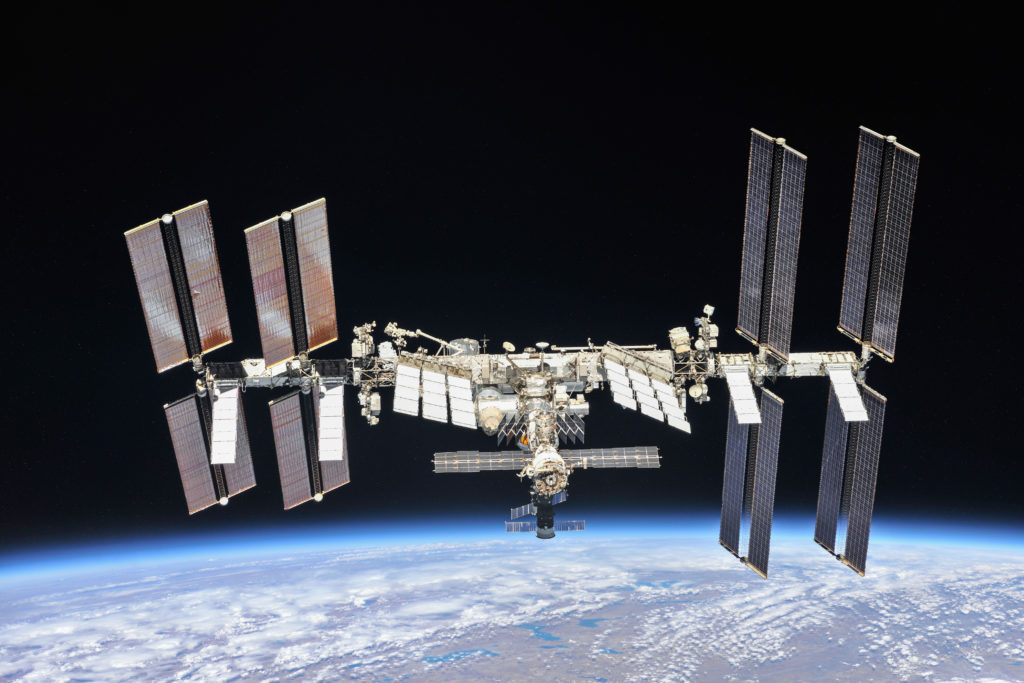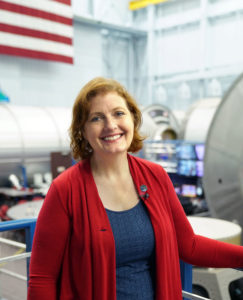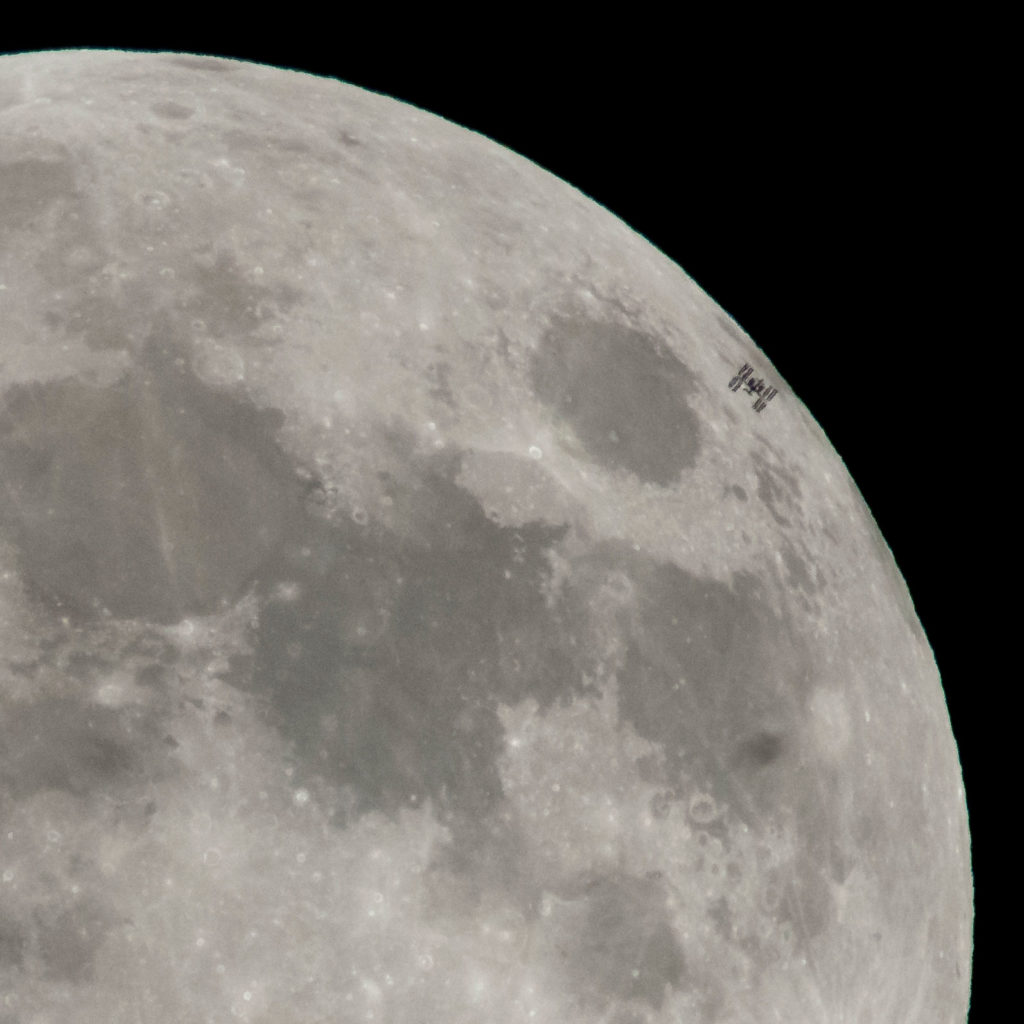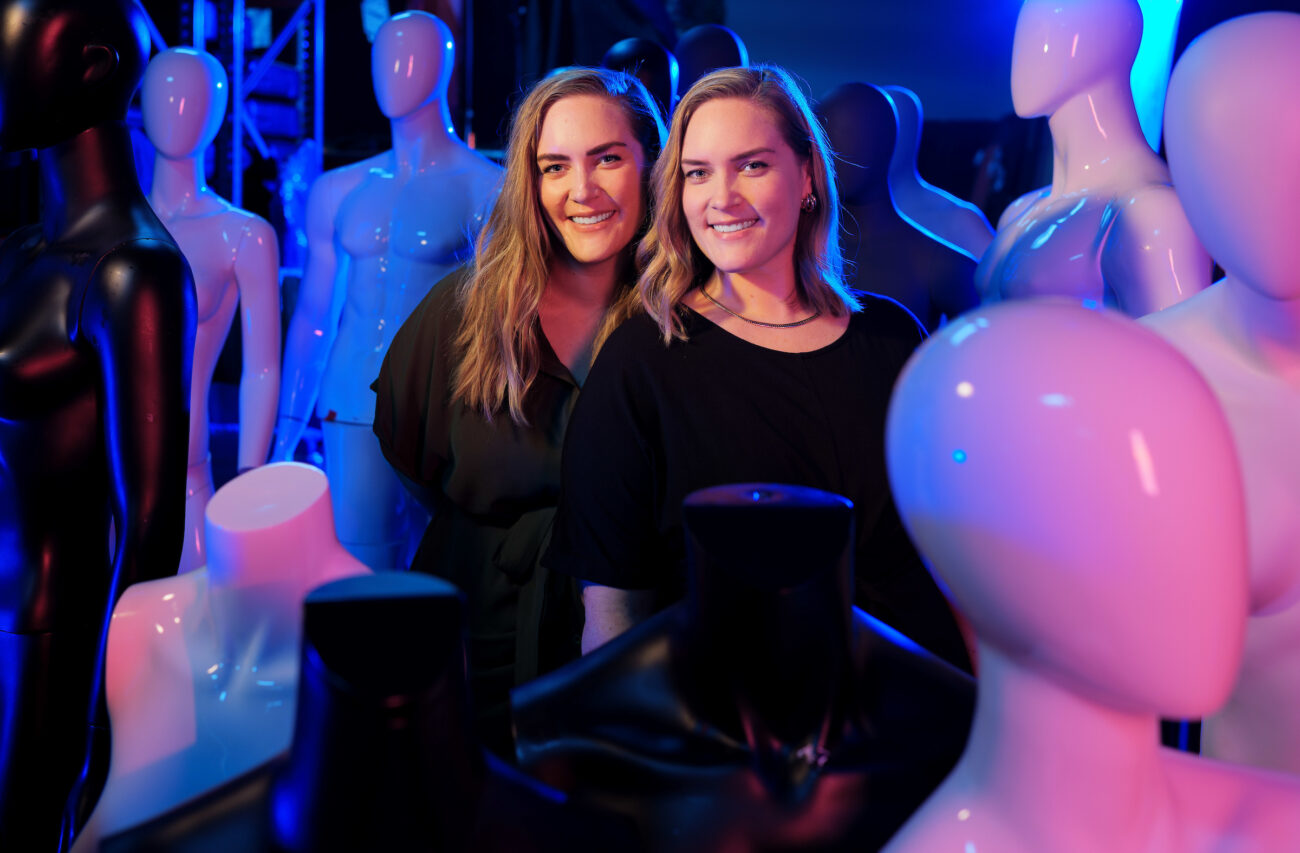One Giant Leap

JULIE ROBINSON DEFTLY STEPS THROUGH THE SQUAT DOORWAYS OF THE INTERNATIONAL SPACE STATION IN KITTEN HEELS.
They click against the glass floor, the only noise in the otherwise empty chamber. The facility at the Johnson Space Center is a medium-fidelity mock-up of the laboratory orbiting 250 miles above the Earth at more than 17,500 mph. Here there is no micro-gravity, no trace of the hundreds of ongoing experiments aboard the International Space Station (ISS). This is where astronauts train for emergency evacuations. And it’s the closest most of us will ever get to experiencing a day in space. At least, for now.
But the road to Mars begins on the ISS. The National Aeronautics and Space Administration (NASA) considers space the next frontier for exploration and expansion. SpaceX, Blue Origin, and Boeing do, too. They are just a few of the companies jockeying to be the first to put humans on Mars. NASA’s own plan to send a mission to Mars isn’t targeted until the 2030s and the race to colonize the red planet has opened the door to advances in space tourism. Innovations in the private sector stimulate people’s imagination, says Robinson ’89, ISS chief scientist, while standing in the node connecting the Japanese, European, and American modules.
“Lower Earth orbit might really become part of the economic sector,” she says. “The same way you can buy an airline ticket, maybe you can buy a space ticket and spend a few days there on vacation. Mars won’t be quite like that for a long time, but the fact that lower Earth orbit could be like that soon is really amazing.”
Robinson was just a baby when the Apollo 11 crew planted an American flag on the lunar surface July 20, 1969.
As Neil Armstrong observed the ground from the ladder of the spacecraft, he remarked that the soil was so fine it was “almost like a powder.” The astronauts collected samples for analysis back on Earth, took photographs, and conducted a handful of experiments. About three hours later they returned to the spacecraft, concluding man’s first visit to the moon. American astronauts haven’t been back since 1972.
“The original Apollo missions didn’t allow women to be part of that overall process. We actually identified women that could have, and then we didn’t let them be part of those early missions. It is a great next step.” – Julie Robinson, ISS chief scientist for NASA
Scientists today are eager to return to explore the poles and establish a sustainable presence that will serve as testing ground for the next horizon: Mars. Last March, Vice President Mike Pence announced that NASA’s newest program Artemis (Apollo’s twin sister in Greek mythology) will continue what Apollo started 50 years ago. In 2024, NASA will land “the first woman and the next
man” on the moon.
“The original Apollo missions didn’t allow women to be part of that overall process,” Robinson says. “We actually identified women that could have, and then we didn’t let them be part of those early missions. It is a great next step.”

Julie Robinson is NASA’s chief scientist for the International Space Station. Photo by Jeremy Jensen.
As a kid in Pocatello, Idaho, Robinson recalls her father, a civil and geotechnical engineer spotting empty parking lots and following his curiosity.
“We would pull over at abandoned shopping malls to see why the foundations had collapsed,” she says. “I grew up pulling over and looking at things. I just fell in love with asking questions and looking at data and my dad definitely taught me that.”
But where he pursued engineering, she wanted something of her own. A biology teacher in high school introduced her to the life sciences—a path Robinson followed throughout her undergraduate years at Utah State University. Robinson first learned DNA sequencing in the late Joseph K-K Li’s’ lab.
“Back then it was this massive undertaking,” she says. “People would spend their whole Ph.D sequencing one virus, which would take you half a day now. And you could do it in your kitchen with some of the equipment we’re using on the space station.”
She also worked in a chemistry lab. Both experiences taught her how research questions worked, but it was the USU Honors program that sealed her fate. By the final semester Robinson was burnt out and frustrated when she met with Joseph Morse, then head of the Honors Program. He asked what her plans were after graduation and mentioned that she was considering not going to graduate school and becoming a teacher.
“He looked at me and he said, ‘If you become a teacher, you’ll have a great impact on a lot of kids’ lives, and you will be a total waste to science,’” she recalls. “‘Please go to graduate school.’”
It was a jarring moment.
“Back then in ’89–90 there wasn’t a lot of encouragement for women to go into science,” Robinson says. “In fact, there was a lot of discouragement … even in my family, which was very conservative, I don’t think it ever occurred to my dad that getting an education was anything but a backup plan to being a mother. When I did go to get a Ph.D I remember him saying ‘Wow, I didn’t know you wanted to do that!’ And I’m like ‘Why wouldn’t I? You had a Ph.D. I wanted to be Dr. Robinson, too.’ If that moment with Joe Morse hadn’t happened, I would have been on a very different path.”
Across the road from the Johnson Space Center a freshwater inlet empties into the feeder waters of Galveston Bay. An alligator cruises where a half-drowned chain-link fence guards an empty strip of pavement. Lizards disappear into the folds of palmettos. A man uses a Coke can wrapped with fishing wire to compete with a statuesque Great Blue Heron across the way. The water is teeming with life.

NASA astronaut Scott Kelly posted this picture of the Bahamas taken from the International Space Station on Twitter on July 19, 2015 as part of his year in space. Photo courtesy of NASA.
This is what first attracted Robinson to Houston in 1997. She came for a postdoc to study what happens to the wetlands when big storm tides come in and the salt marsh disappears. “What I was interested in was what happens to all the salt marsh sparrows? What happens to the rodents that live in the marshes?” she says.
Robinson thought her future was as a professor. Then she met people at NASA who were looking for an ecologist to help train astronauts preparing to go to MIR, the now retired Russian space station. They wanted someone who could help astronauts understand the world that they were going to see, Robinson says. “Because for the first time, instead of just being up for two weeks for a quick shuttle mission, they were going to be up long enough to see seasonal changes and floods and droughts and compare what they saw to what it used to look like.”
These days astronauts spend about six months aboard the ISS. That figure will grow as NASA ramps up plans to send astronauts on multi-year missions to places like Mars. In 2016, NASA’s Scott Kelly and Cosmonaut Mikhail Kornienko of the Russian Federal Space Agency spent a year in space to test the effects of long exposures to microgravity on the body. Kelly spent much of the days watching the ever-changing canvas of the Earth. He witnessed the blizzard of 2016 frost the East Coast below, conducted experiments on himself, and tended the first flower grown in space—a bright smear of orange amidst the vacuum of space he Instagrammed with the caption “Yes, there are other life forms in space!”
The space station is an engineering and diplomatic feat. Since its launch in 1998, five space agencies including Russia, Japan, Canada, Europe, and NASA share responsibility for the ISS and have collaborated on more than 2,000 experiments. The names of the various components built by each agency reflect the lofty goals of the project: Hope, Columbus, Destiny, Harmony, Unity. The ISS is a place where things can be different than politics on the ground.
“We all have to work together to keep the crew alive, to keep the crew healthy, and keep the work going,” Robinson says.
Some of that work will help propel humankind the farthest we’ve ever been from home.
This is a really old concept, Robinson says, pointing to a vertical wall of plants encased behind glass. “We don’t have anything like that on orbit now. But as scientists consider what type of food system will be needed to send a crew to Mars, the vision of a vertical greenhouse is not so far-fetched.”
Much of the original work of growing plants in space focused on getting them to grow in microgravity. It shifted to studying if produce grown on the ISS was safe to consume. The question now, Robinson explains, is what should we be growing? “If you saw the movie The Martian and they’re growing all those potatoes. I’m an Idaho girl, but you do not want to be living off of potatoes. You are going to be malnourished if that’s your major source of food.”
“On the space station we have tons of meaningful work because we have got all of this research. But when you go to Mars you are going to be so mass limited. You are going to really have to strip it down to what you need to survive. And so then how do you make sure the crew has meaningful work?”
Calculations suggest it may take about one year to travel to Mars from Earth and certain nutrients won’t survive the journey in ready-made meals. Designing a sustainable food system that can provide vital micronutrients and vitamins is a critical part of keeping crews healthy because the MRE style packaged foods consumed by astronauts on the ISS today won’t cut it. NASA will test a potential food system for Mars on the ISS for several years before a crew deploys.
“We have to figure out what do we have to produce along the way and then what’s the technology that we need that we can reliably use to produce that food?” Robinson says. “The space station is really fundamental to proving that something could work for long enough that it could be part of the critical food system. If the food system fails, the crew could get really sick on the way to Mars. Just like sailors got scurvy in the days of the great sailing vessels because they didn’t know about vitamin C.”
But a balanced diet is just one aspect of crew health. What about the effects of radiation? How much exercise does the crew need to prevent bone loss? These are questions scientists are exploring because human beings will be sent to Mars. Human beings are complex organisms with feelings and desires and fears. Ensuring astronauts stay mentally healthy is also important. That’s why isolation and confinement studies are also tested on the ISS. Understanding crew dynamics and how to support astronauts when they are far from home will become increasingly important on long duration missions when communications blackouts are expected and stepping out for a walk to blow off steam is not an option.
“How do you make sure they have meaningful work?” Robinson asks. “On the space station we have tons of meaningful work because we have got all of this research. But when you go to Mars you are going to be so mass limited. You are going to really have to strip it down to what you need to survive. And so then how do you make sure the crew has meaningful work? Is it cooking? Is it growing food?”
Growing plants may supply the crew with needed micronutrients and also fulfill another purpose—they remind astronauts of home.

NASA Expedition 46 Commander Scott Kelly tended zinnias during his year aboard the ISS. On Jan. 16, 2016, he posted a series of photos of the first flowers grown in space. Photo courtesy of NASA.
“When crew members have flown when we didn’t have a greenhouse some of them still figured out how to grow things,” Robinson says, describing how Don Pettit sprouted seeds in a pair of socks when he was on the ISS. “Humans want life around us. That is a really important part of what being human is, and something we have to think about when we go on these missions.”
A row of white spacesuits—relics of a time before digital cameras and satellite phones—flank Robinson as she walks out of the test facility and into the warm, humid air of a Houston afternoon. She drives to the Human Health and Performance Laboratory to meet with Sarah Wallace, a NASA microbiologist whose lab monitors the air, water, and surfaces of the ISS so the crew and craft stay healthy. As she leads the way to the microbiology lab Robinson praises Wallace’s innovative drive and greets her with a hug and wide smile.
In many ways Robinson is an ideal messenger for space station science. The majority of the workforce at the Johnson Space Center are engineers and Robinson credits her dad with helping her speak engineer early in life. But as a former science researcher, Robinson appears genuinely pleased to talk about the work she oversees. Her blue eyes flicker with excitement whether she’s talking about research on the ISS potentially helping to streamline drug testing or possibly improving models for cancer growth.
The way we have been monitoring microbes on the ISS, really since back to Apollo, was using culture-based approaches, which is really the gold-standard for microbiology, Wallace says. “What my work has been trying to do, is move us past that.”
A pile of augur plates sealed in packages rests on a workbench.
“This is not okay,” Robinson says holding one up. “You are culturing things in space that are bad for you. Why would you want to culture those in a closed environment? Number two, this is a lot of mass. Then you have to bring it home to Earth to figure out what the heck it is and you can’t do that on the way to Mars. So, it’s just a huge amount of mass and wasted effort. The other thing I don’t like about it is you’re not culturing everything.”
Wallace tracks innovations in technology on the ground and determines how to adapt them for space. For instance, new instrumentation allows scientists to take a single swab of something, like the soil, and find all of the bacteria that are in the sample.
“This guy does the same thing,” Wallace says displaying a tiny device called the min-ION in her palm. The sequencer doesn’t just detect DNA, but also RNA. It can detect anything such as nucleic acids that we aren’t really familiar with yet, Wallace explains. “We say things a lot like ‘Oh, this is game changing,’ but I really think because not only will it help me with the here and today with the microbiology questions we have, but it can help … in the future as we look for life beyond Earth.”
The methods will also allow astronauts to do more than sequence in real time.
“Throughout human history there have been times when humans made these amazing leaps and got to a different continent, got to a different island chain. That nature of humans as explorers is one of the reasons that we have survived so well as a species. It also may be the thing that saves us someday.”
When you put something alive in space it changes, Wallace says. Some genes turn on and off to better survive in space. Usually the changes that occur are in the RNA, not the DNA, as far as we know, she continues. “We suspect there may be heritable changes happening in the DNA.”
Scientists are conducting a long-term experiment with a bacteria cell line to test if mutations are actually happening in its genome and at what rate. But the ability to swab and sequence in real-time goes beyond microbial monitoring on the ISS. It could help detect manmade changes to the environment.
“We were so worried if we found life in the lunar soil, did we put it there?” Wallace says. “It’s going to be the exact same thing with Mars—only worse. Could we contaminate a planet with Earth things and then either one, lose our ability to find something that was there native to Mars, or two, kind of ruin Mars?”
Not all research on the ISS is so outward looking. About half of the research focuses on improving life on Earth. Hurricane prediction tools, advances in water purification, and drugs to treat osteoporosis—all have been tested on the ISS. But it took a while to get the space station fully functioning as a lab.
“For the first 50 years of space flight, if it didn’t work, you were usually out of luck because it was so hard to get access,” Robinson says. “We’ve turned that corner. We [now] have enough facilities, enough cargo flights, we have enough crew members on orbit that can do the work … so we are actually operating like a real lab now, but it took a long time because space is really hard.”

The ISS is actually visible from Earth. Here it makes a transit in front of the moon. Photo courtesy of NASA.
When Robinson took over as chief scientist in 2006, NASA was undergoing a period of reinvention. After the 2003 Columbia accident where seven astronauts were killed during re-entry, it forced a public questioning of the shuttle program and whether humans should be in space, or not. The shuttle program was retired and funding for scientific investigation was slashed. Part of Robinson’s job has been rebuilding the threads of research that were lost. Nearly 15 years later, she is helping NASA scientists lay the groundwork for the operational and scientific experiences crews will need to establish human outposts on the moon and Mars.
“Even in high school we were talking about how fragile the Earth is, how vulnerable the Earth could be to some catastrophic event,” she says. “Throughout human history there have been times when humans made these amazing leaps and got to a different continent, got to a different island chain. That nature of humans as explorers is one of the reasons that we have survived so well as a species. It also may be the thing that saves us someday.”
“I think of how we need to take care of the Earth we’ve got,” she says. “We are many generations away from having any other alternatives—real alternatives for real numbers of people. But I also believe that being a multi-planet species is a really good insurance policy.”
And the next giant leap.





